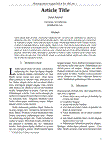| Summary: | nutrients for human consumption and an invaluable export item for many countries. Market prices have increasedfor many human food sectors; yet, the farm gate value for seafood products have declined or at best had marginalincreases in price. Unfortunately, at the same time feed, fuel and processing costs are rapidly increasing pushingmany of the world’s producers to cut their production costs or go out of business. For those who would like toremain in the industry we must be willing to adapt to changing markets and adjust production processes tomaximize investment returns. If we are to remain competitive, we must know our cost structures and re-evaluateproduction practices. It is time for the industry to review there production practices, confirm production values aswell as costs so they can bet back to the basics of cost effective management and optimized feed formulations.There are no easy solutions to reducing production costs and there are no-magical solutions (that work) for sale one-bay. Producers who know their system costs and inefficiencies can improve and have a chance of being costcompetitive. Starting at the feed mill we must: 1) set nutrient restrictions for our feed formulations using the mostup to date numbers and not rely on fish meal to make a good feed 2) select our ingredients based on costeffectiveness and quality 3) optimize mill processes to reduce production costs. At the farm, we must look at ourmanagement strategies in the light of economic efficiency and optimize feed inputs to provide the best overall returnon our investment. By systematically improving the management of our systems we should be able to improve feedconversion, reduce our dependence on water exchanges and improve overall efficiencies.
|
|---|
